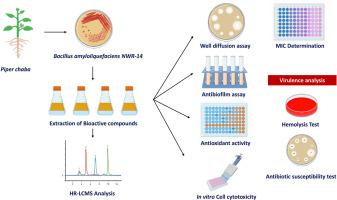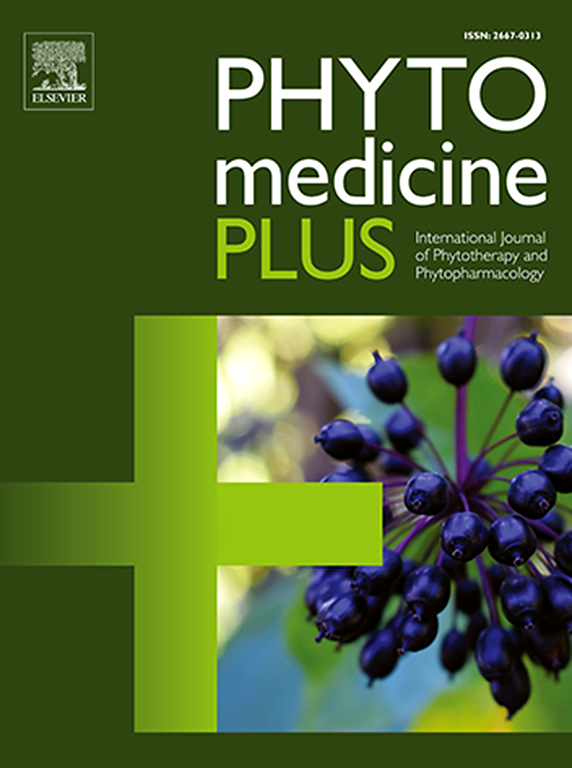木瓜内生解淀粉芽孢杆菌NWR-14的HR-LCMS分析、体外和计算机评价
Q3 Pharmacology, Toxicology and Pharmaceutics
引用次数: 0
摘要
多药耐药(MDR)病原体如肺炎克雷伯菌的增加,特别是那些产生广谱β-内酰胺酶(ESBL)的病原体的增加,加强了对新型生物活性化合物的研究。药用植物,包括番椒,宿主内生细菌,可能作为抗菌剂的有前途的来源。目的研究解淀粉芽孢杆菌NWR-14对产esbl肺炎克雷伯菌的抑菌、抗生物膜、抗氧化和细胞毒性。分离得到解淀粉faciens NWR-14,并通过16S rRNA基因测序对其进行鉴定。采用MIC和MBC测定了该分离物的乙酸乙酯提取物的抑菌活性。结晶紫染色测定抗菌膜电位。采用扫描电镜观察肺炎克雷伯菌的形态学变化。采用HR-LCMS对生物活性化合物进行推定注释。通过硅分子对接来评估与CTX-M-15 β-内酰胺酶的结合亲和力。采用DPPH、FRAP和ABTS检测抗氧化活性,并对成纤维细胞进行细胞毒性测试。结果该提取物具有明显的抑菌活性,MIC和MBC均为1.56 mg/mL,呈剂量依赖性,在6 mg/mL时抑菌效果最佳。扫描电镜分析证实肺炎克雷伯菌有明显的细胞损伤。HR-LCMS分析推测注释了76种化合物,包括生物碱、皂苷和酚酸。分子对接发现,8′-羟基二氢麦角胺和甘草皂苷E2等化合物与CTX-M-15具有较强的结合亲和力。该提取物具有中等抗氧化活性和较低的细胞毒性,成纤维细胞存活率在97%以上。解淀粉faciens NWR-14是一种具有抗菌、抗生物膜和抗氧化特性的生物活性次生代谢物。这些发现强调了药用植物内生细菌作为解决抗菌素耐药性的化合物储存库的潜力。建议进一步纯化和结构验证活性成分,以提高治疗适用性。本文章由计算机程序翻译,如有差异,请以英文原文为准。

HR-LCMS profiling, in vitro and in silico assessment of the antibacterial activities of endophytic Bacillus amyloliquefaciens NWR-14 from Piper chaba W. Hunter
Background
The rise of multidrug-resistant (MDR) pathogens such as Klebsiella pneumoniae, particularly those producing extended-spectrum β-lactamases (ESBL), has intensified the search for novel bioactive compounds. Medicinal plants, including Piper chaba, host endophytic bacteria that may serve as promising sources of antimicrobial agents.
Purpose
This study aimed to evaluate the antibacterial, antibiofilm, antioxidant, and cytotoxic properties of secondary metabolites derived from Bacillus amyloliquefaciens NWR-14, an endophyte isolated from P. chaba, with a focus on its activity against ESBL-producing K. pneumoniae.
Methods
B. amyloliquefaciens NWR-14 was isolated and identified via 16S rRNA gene sequencing. The ethyl acetate extract of this isolate was tested for antibacterial activity using MIC and MBC assays. Antibiofilm potential was assessed using crystal violet staining. Scanning electron microscopy (SEM) was employed to visualize morphological changes in K. pneumoniae. HR-LCMS was used to putatively annotate bioactive compounds. In silico molecular docking was conducted to assess binding affinities to the CTX-M-15 β-lactamase enzyme. Antioxidant activity was evaluated using DPPH, FRAP, and ABTS assays, and cytotoxicity was tested on fibroblast cells.
Results
The extract exhibited notable antibacterial activity with a MIC and MBC of 1.56 mg/mL, and showed dose-dependent biofilm inhibition, achieving maximum effect at 6 mg/mL. SEM analysis confirmed significant cellular damage in K. pneumoniae. HR-LCMS analysis putatively annotated 76 compounds, including alkaloids, saponins, and phenolic acids. Molecular docking revealed strong binding affinities of compounds such as 8′-Hydroxydihydroergotamine and Licoricesaponin E2 to CTX-M-15. The extract demonstrated moderate antioxidant activity and low cytotoxicity, with over 97% cell viability in fibroblast assays.
Conclusions
B. amyloliquefaciens NWR-14 shows promise as a source of bioactive secondary metabolites with antibacterial, antibiofilm, and antioxidant properties. These findings underscore the potential of endophytic bacteria from medicinal plants as reservoirs of compounds for addressing antimicrobial resistance. Further purification and structural validation of active constituents are recommended to enhance therapeutic applicability.
求助全文
通过发布文献求助,成功后即可免费获取论文全文。
去求助
来源期刊

Phytomedicine Plus
Medicine-Complementary and Alternative Medicine
CiteScore
3.70
自引率
0.00%
发文量
178
审稿时长
81 days
期刊介绍:
 求助内容:
求助内容: 应助结果提醒方式:
应助结果提醒方式:


